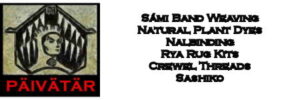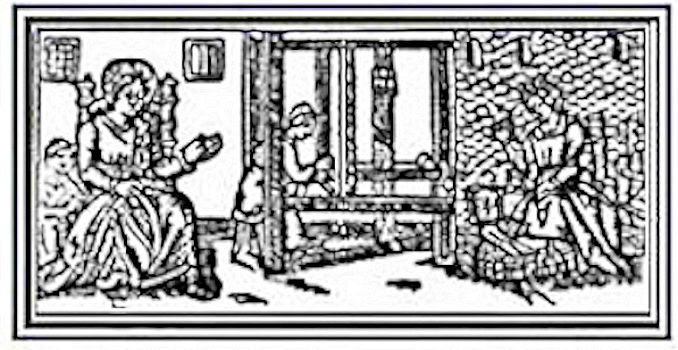As the weaving progresses, the weaver slides the finished cloth
around the cloth beam at her waist to the under side of the warp loop and
continues working with new, unwoven warp exposed on the upper surface.
When all or most of the circular warp has been woven she will have a large
tube of cloth which can be cut across the last of the unwoven warp, taken
off the loom and opened out to make a flat piece of cloth. Most of the
clothing of the-Atayal is made by wrapping, folding or tucking flat pieces
of cloth or by making smaller tubes of cloth and then sewing the tubes
together into simple garrnents. The woven cloth is seldom cut to shape
and tailored to fit the body. For weavers who are familiar with weaving
terminology, I should point out that this black and white pattern woven
on one heddle rod plus a second shed created with a shed sword/beater.
The simple cloth produced is similar to the patterns typically woven on
the inkle loom.
By using a thin stick to pick up selected individual warps and
inserting an additional colored weft thread the Atayal weaver can make
beautiful and intricate (although time consuming) patterns such as the
one shown below.
Atayal diamond pattern made by picking up individual warps and inserting
additional colored weft thread.

Antique Ramie Textile, The Sung ye Musem of Formosan Aborigines, Taipei
The lines and broken bands of black and white remind the Atayal
of the tattooed patterns they once wore on their faces diagonally part
way across their cheeks. I was told that these tattooed patterns were marks
of beauty, and identified the wearer as a member of a particular tribal group. Apparently
they functioned as a kind of “passport” as people moved in and out of their
own tribe’s territory. In former days many of these groups were head hunters
an you’d want to be sure to be able to identify yourself quickly!
I was told a lovely story by an Atayal weaver acquaintance. She
said that long ago her people believed when a member of their tribe died
the person’s tattoo was also the “passport” which allowed him or her to
cross “the Rainbow Bridge” to where deceased friends and relatives await
the soul on the other side!
“Ancestors”
Photo taken during the period of Japanese occupation of Taiwan

* For more information about Taiwan aboriginal culture and history contact
Ms. Yi-Ting Cheng at the Sung ye Museum of Formosan Aborigines 282, Chihshan
Rd., Sec. 2, Taipei, Taiwan
** Kathleen Forance Johnson is a weaver and art educator, and has recently
returned to Washington D.C. after living in Taiwan for three years where
her husband was Director of the American Institute in Taiwan (formerly
called the USA EMBASSY). She is a member of the Waterford Weavers Guild.
Kathleen
kdnjohnson at starpower.net
Weaving Books: Ethnic Textiles
Navajo Weaving in the Late Twentieth Century: Kin, Community, and Collectors
[sc name=”medianet300x250″]
[ebayfeedsforwordpress feed=” http://rest.ebay.com/epn/v1/find/item.rss?keyword=weaving+loom&categoryId1=14339&sortOrder=BestMatch&programid=1&campaignid=5336495175&toolid=10039&minPrice=100.0&listingType1=All&descriptionSearch=true&feedType=rss&lgeo=1″ items=”3″]
[sc name=”Amazon-Bottom”]
 LONGTHREAD MEDIA VIDEO
LONGTHREAD MEDIA VIDEO
 LONGTHREAD MEDIA SUBSCRIPTIONS
HANDWOVEN MAGAZINE
PIECEWORK MAGAZINE
SPINOFF MAGAZINE
LEARN LONGTHREAD MEDIA
PAIVATAR HANDMADE
LONGTHREAD MEDIA SUBSCRIPTIONS
HANDWOVEN MAGAZINE
PIECEWORK MAGAZINE
SPINOFF MAGAZINE
LEARN LONGTHREAD MEDIA
PAIVATAR HANDMADE
 Paivatar on YouTube
Visit my YouTube channel for how-to craft videos.
Paivatar on YouTube
Visit my YouTube channel for how-to craft videos.
Or Please visit my Channel on Rumble for more how-to videos.
https://rumble.com/Paivatar
LIVE STREAMS - Paivatar Studio
KICK
TWITCH MAKERS&CRAFTING
YOUTUBE
Categories: Heritage Crafts


